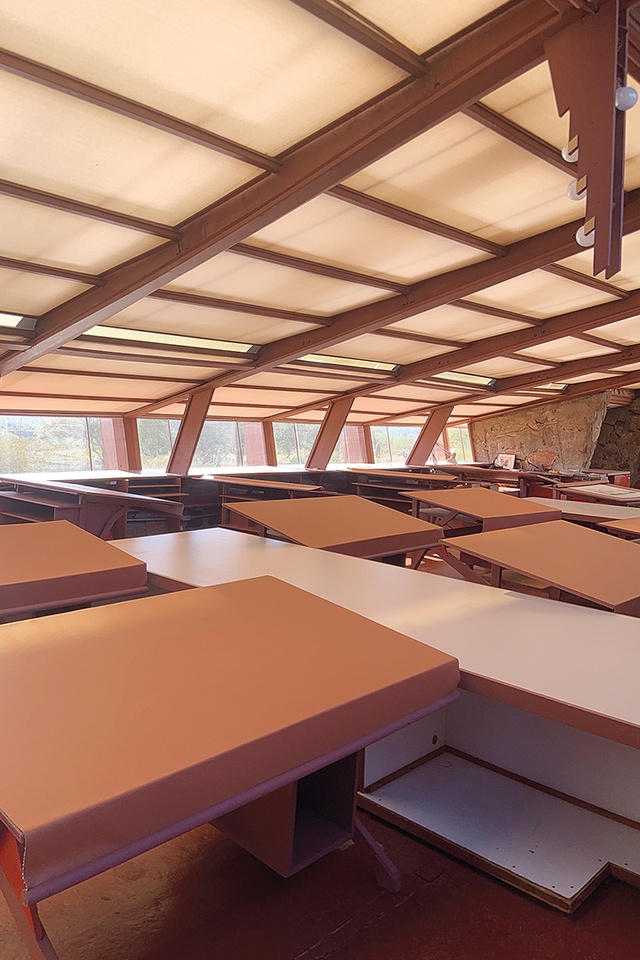Before there was dank, there was Frank
Karamia Müller calls for more irony, cynicism and criticality over beauty, earnestness and elitism upon revisiting the architectural satire account: @dank.lloyd.wright.

The last column I wrote made a case that the isms of Eurocentric legacy architecture were a bit of a plague for the building practices of indigenous people. Further, that one of the losses accounts for the devaluing of ideas and approaches to collective being that may have resided in local knowledges. Since then, well, I have been thinking about… the architectural satire account: @dank.lloyd.wright.
As an intermittent social media user, I was reminded of it when reading Professor of Design Studio in the School of Architecture at Te Herenga Waka Victoria University of Wellington’s Daniel Brown’s opinion piece: ‘The issue of unpaid internships in architecture offices’1. I tend to agree with the views therein. Unpaid labour in any sector is at a disconnect with the cost of, well… everything but, especially, the most baseline of human needs such as housing: renting let alone home ownership. Free architectural labour in the name of work experience comes into contact with the cost of living and the cost of living wins. You do not need to track the official cash rate to know this; it is something we are living in.
That said, if you were fortunate to be generationally situated as a home-owner from the 2000s and earlier… you may be, let’s say, buffered from it. You may see an internship as workable if you want something enough. What I find fascinating about an Instagram account such as @dank.lloyd.wright is it appears to see such a position as one deserving challenge, with a forthrightness that is new to me. And then there is the tone. The admins of the account express “a disaffection for architecture that comes from a deep disappointment in its role as a decorator for finance capital.”
There’s a lot going on here. Disaffected and disappointed together are pretty damning. And then, then the coup d’état, the evocation of architecture as interior design: sacré bleu. I personally am quite into the implied irreverence. I, too, have often thought that the architectural profession could open itself up to more irony less beauty, more cynicism less earnestness and more criticality less elitism. I have felt disaffected and disappointed when I have considered that these views have been dismissed as if they were adolescent angst.
The thing that @dank.lloyd.wright reveals for me is that ideologies that have been unquestioned, or at least very quietly questioned, are now being picked apart with conceptual tools that are making light work of architectural practice that was, in my time as an architecture student and recent graduate – lauded. This approach appears to be not enough for @dank.lloyd.wright or its followers. This is fair.
Interestingly, many of the memes go over my head; I think this is a generational thing. It is the cultural production of a generation that will have digitally manipulated images in a portfolio submission to an architecture school and it’s likely that submission would also have been made online to a portal. For my own portfolio submission back in, I don’t know, what feels like the early 19th century, I double-side taped my best paintings cut directly from my Bursary board onto blank white refill, which I then labelled with my best handwriting.
Perhaps also not unrelated, this is the generation that would have come of age well after events such as 9-11 and completed their architectural education or worked as graduates in architectural offices as a pandemic shut down offices, cities, countries. I think, if I am to answer the earlier question with these things in mind, it is about agency and expression that is invested in social organisation. And that it is contextual.
I am surprised I land here. I thought when I started writing that I would end up somewhere else, discussing how the semiotics of internet memes will likely shape the built realm. By some cosmic twist, while I was mentally drafting this column, I was in Phoenix, Arizona, the winter home of architect Frank Lloyd Wright. Before there was dank, there was Frank. Because my last engagement with any teeth with Frank Lloyd Wright was as an undergraduate studying for an architectural history paper, I had forgotten about Arizona’s importance to Wright and so had not planned to visit any of his buildings.
It was a colleague who pointed out Frank Lloyd Wright Boulevard and suggested an impromptu visit to the Foundation housed at Taliesin West, the desert classroom Wright constructed with apprentices. A closed gate and a couple of attempts later (note, everything in Arizona seems to open after 10am), and I found myself in what the Foundation describes as the architect’s desert laboratory, with a guided tour headset sprouting from both ears.

Taliesin West was the headquarters for Wright’s office and apprenticeship programme: The Taliesin Fellowship. The, let’s say… programme was managed by Wright’s wife Olgivanna whose influence, reading between the lines, was Hilary Clintonish in nature. She kept things running, while he could profession. As I took in the overall tableau of Taliesin, the rusts and greyed yellows of the desert refracted through the buildings’ masonry and redwood beams; when the sun sets so, too, do the walls of Taliesin West. My recorded tour guide informed me that at the centre of its construction was a desire to build a world of shared values and practice. Everyone was expected to share in domestic duties, ongoing construction of an unfolding complex and anything else that required the community to self-sustain.
Interestingly, those practices were conceived as appropriately renumerated, not in money but in participation. The pay for graduates was poor, which was an improvement on the apprentices who were expected to work for nothing. The thing that you were gaining was an architectural education; anything on top of that was considered a bonus. Now that I am at my desk, completing the task of this column, without Taliesin West resplendent before me, and having just put my phone down after gazing at recent @dank.lloyd.wright memes on AI and Zaha Hadid, I have the sense that, even though I don’t have the lexicon to be in the inner circle of the joke, they have a point. Buildings must ethically live up to the same standards of beauty that are desired by their architects. Otherwise, as the world spirals, what is the point?
1 architecturenow.co.nz, 7 Oct 2022.
Read a response to this column from architectural designer Tessa Forde (BAS) (MArchProf) here.









